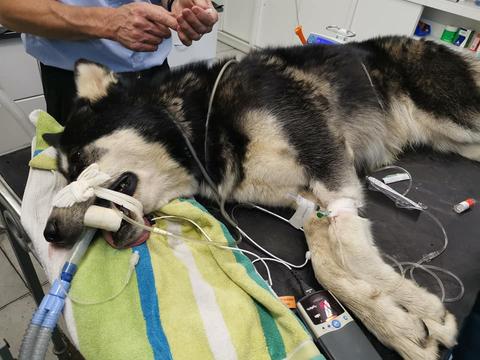
https://www.iol.co.za/dailynews/news/kw ... WQDdt8ZTzU
Durban - "Miraculous" is one word used to describe the survival of an Alaskan Malamute dog that was brought back from the brink of death after being bitten by a Black Mamba in Westville.
The dog received eight vials of antivenom.
It was an emotional roller coaster for Nick Evans of the KwaZulu-Natal Amphibian and Reptile Conservation and the dog's owner following the incident in Northcliffe Avenue on Monday.
Evans said the mamba had slithered onto a property and was confronted by three dogs and a security guard.
Evans said the dogs barked ferociously at the snake, while the guard attacked it with a stick, beating it to death.
"During the struggle and out of instinct, the dog named Diesel attacked the mamba, biting it two or three times. This action was going to result in the dog being bitten in return. Fortunately, the homeowners were present and heard the commotion. They noticed something wasn't right with their dog and rushed him to a vet," Evans said.
The two-and-a-half-year-old Diesel managed to walk into the vet but as he entered, he collapsed. Evans said the venom was taking effect.
"The vets immediately administered the two vials of antivenom kept on the premises, but it didn't seem to have too much of an effect. Diesel was crashing.
I was called in. At the time of the call, I was in Sherwood, which is about 10 minutes from St Augustine's Hospital. I knew the dog would need more than two vials. I knew exactly who would be able to help. I contacted Dr Kevin McEwen from St Augustine's," he said.
"I phoned him and he didn't hesitant into readying the antivenom for me. He prepared two vials and I raced over to Westville to collect them. Four vials is what saved Jasper, the lucky terrier who survived a mamba bite last year. Diesel was on a ventilator. His blood pressure had dropped, as had his heart rate. The neurotoxic venom quickly shutting his body down," Evans explained.
"The two vials were injected, and we waited. Those two extra vials barely stabilised him. We could see he wasn't going to improve without more antivenom," he said.
Evans said he contacted McEwen to ask for two more vials. He said when he returned to the vet, he could feel the mood in the room was anxious.
"Apparently Diesel had a seizure when I left. He had crashed completely. He was dead at a stage, before being resuscitated. It wasn't looking good at all for him. The two vials of antivenom were administered and again, it was a waiting game. However, he seemed to have stabilised. He wasn't breathing on his own, he was on a ventilator, but his vitals were stable," Evans said.

Diesel being treated at the Westville Veterinarian. Picture by Nick Evans.
Evans said when he looked at the snake's body, he found it to be a spectacular male specimen - 2.6m long, and well-fed!
"It was gut-wrenching to see this snake like this and to know what happened. The thought of the dog dying on top of all this was just worsening my mood. The dog owner phoned and was concerned that he wasn't improving. He asked if I could get more antivenom. So I consulted Dr McEwen and Arno Naude, my snakebite assistant. They said more antivenom could only do good," he said.
The dog owner fetched two vials from Hillcrest Vet.
Evans said Diesel was still stable, but his life was still on the line.
"He had started breathing by himself! A hugely positive sign! On Wednesday, he was starting to respond to sounds and being touched, particularly when his family went to see him! But he couldn't stand. On Thursday morning, I got the good news - Diesel was up on his feet! Ah! I was so relieved and excited! I went into see him. He was panting a whole lot, but walking around and loving his family," Evans said.
He said Diesel was very lucky and had a fighting spirit. Evans said usually dogs don't make it to the vet after a mamba bite.
Evans thanked Dr McEwen
"Without his prompt organisation of the antivenom, Diesel would have been dead before nightfall. Those four vials kept him alive and gave him the best possible chance," he said.
He also thanked Naude and the vets who assisted.
"Diesel's family was determined to see their dog live," Evans said.
He further explained that it was not the mamba or dog's fault.
"The snake did not intentionally attack the dog but when left without a choice, it had to defend itself, like any animal or human would. One can't blame the dogs either, as they act out of instinct, and perhaps want to protect their families. We see conflict like this every year, and its just horrible. At least this one ended well for the dog," Evans said.
Daily News




